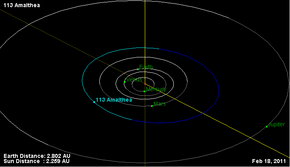113 Amalthea
 Orbital diagram | |
| Discovery | |
|---|---|
| Discovered by | R. Luther |
| Discovery site | Bilk Obs. |
| Discovery date | 12 March 1871 |
| Designations | |
| (113) Amalthea | |
| Pronunciation | /æməlˈθiːə/ |
Named after | Amalthea |
| A871 EA; 1931 TN3; 1951 CY | |
| main-belt · Flora | |
| Orbital characteristics[1] | |
| Epoch 31 July 2016 (JD 2457600.5) | |
| Uncertainty parameter 0 | |
| Observation arc | 144.90 yr (52926 d) |
| Aphelion | 2.5819 AU (386.25 Gm) |
| Perihelion | 2.17010 AU (324.642 Gm) |
| 2.37598 AU (355.442 Gm) | |
| Eccentricity | 0.086651 |
| 3.66 yr (1337.7 d) | |
| 226.48° | |
| 0° 16m 8.832s / day | |
| Inclination | 5.0422° |
| 123.486° | |
| 79.118° | |
| Physical characteristics | |
Mean diameter | 46.14±1.4 km |
| 9.950 h (0.4146 d) | |
| 0.2649±0.017 | |
| S | |
| 8.74 | |
113 Amalthea (/æməlˈθiːə/) is a stony Florian asteroid from the inner regions of the asteroid belt, approximately 50 kilometers (31 miles) in diameter. It was discovered on 12 March 1871, by German astronomer Robert Luther at the Bilk Observatory in Düsseldorf, Germany. The elongated S-type asteroid has a rotation period of 9.95 hours. It was named after Amalthea from Greek mythology. A purported satellite of Amalthea was announced in July 2017, but was later found to be a software error in July 2021.[2]
Description[edit]
Amalthea is thought to be a fragment from the mantle of a Vesta-sized, 300–600 km diameter parent body that broke up around one billion years ago, with the other major remnant being 9 Metis.[3] The spectrum of Amalthea reveals the presence of the mineral olivine, a relative rarity in the asteroid belt.[4][5]
Based on observations made during a stellar occultation by Amalthea of a 10th-magnitude star on 14 March 2017, it was announced in July 2017 that the asteroid has a small, 5-kilometer-sized satellite, provisionally designated S/2017 (113) 1. However, the satellite was later retracted as a software-reduction coding error on 17 July 2021.[2] The occultation also indicated that Amalthea has a distinctly elongated shape.[6]
One of Jupiter's inner small satellites, unrelated to 113 Amalthea, is also called Amalthea, as is a (apparently fictional) small Arjuna asteroid in Neal Stephenson's 2015 novel Seveneves.
References[edit]
- ^ Yeomans, Donald K., "113 Amalthea", JPL Small-Body Database Browser, NASA Jet Propulsion Laboratory, retrieved 12 May 2016.
- ^ a b Green, Daniel W. E. (17 July 2021). "RETRACTION OF REPORT ON (113) AMALTHEA". Central Bureau Electronic Telegrams. Central Bureau for Astronomical Telegrams. Retrieved 17 February 2022.
- ^ Kelley, Michael S.; Gaffey, Michael J. (March 2000), "9 Metis and 113 Amalthea: A Genetic Asteroid Pair", Icarus, 35 (144): 27–38, Bibcode:2000Icar..144...27K, doi:10.1006/icar.1999.6266.
- ^ Cloutis, E. A. (March 1993), "Olivine-rich asteroids, pallasitic olivine and olivine-metal mixtures: Comparisons of reflectance spectra", Lunar and Planetary Institute, Twenty-fourth Lunar and Planetary Science Conference. Part 1: A-F, pp. 317–318, Bibcode:1993LPI....24..317C.
- ^ Burbine, T. H.; et al. (July 2000), "The Nature of Olivine Asteroids", Meteoritics & Planetary Science, vol. 35, pp. A35, Bibcode:2000M&PSA..35R..35B, doi:10.1111/j.1945-5100.2000.tb01796.x.
- ^ Beatty, Kelly. "Amateur Observers Find an Asteroid's Moon". Sky & Telescope. Retrieved 15 July 2017.
External links[edit]
- 113 Amalthea at AstDyS-2, Asteroids—Dynamic Site
- 113 Amalthea at the JPL Small-Body Database
